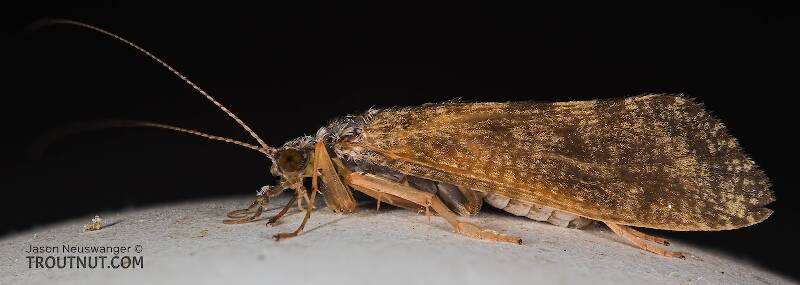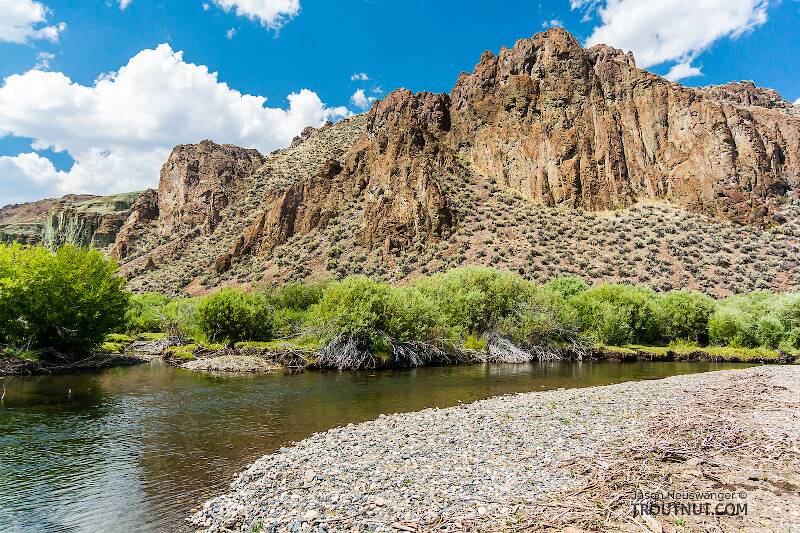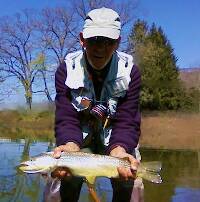
Hex Mayflies
Hexagenia limbata
The famous nocturnal Hex hatch of the Midwest (and a few other lucky locations) stirs to the surface mythically large brown trout that only touch streamers for the rest of the year.
Featured on the forum


Troutnut is a project started in 2003 by salmonid ecologist Jason "Troutnut" Neuswanger to help anglers and
fly tyers unabashedly embrace the entomological side of the sport. Learn more about Troutnut or
support the project for an enhanced experience here.
Wbranch on Apr 8, 2009April 8th, 2009, 2:43 pm EDT
The answer is probably here somewhere in the archived forum posts but I don't know specifically where to find, or look, for it. On Monday I was at the Yellow Breeches and there was a good number, enough that they were crawling onto me, of a caddis about a #12 with mottled gray and black wings and a black body. Anyone here care to tell me what the common name might be and what fly patterns have been developed to imitate it? As I've seen in most caddis emergences the trout pretty much ignored the adults floating on the surface of the river, even flittering adults were unmolested, while there were many splashy rises indicating to me that the trout were eating the pupa rising in the water column. Does the pupal form also have a slate, or black, colored body and black wing pads or stubs? Thanks.
Catskill fly fisher for fifty-five years.
LittleJ on Apr 8, 2009April 8th, 2009, 3:50 pm EDT
I would think that this time of year it would be a chimarra (little black), and their larva is ginger/orange. However I don't know that they get that large, usually a 16 or 18 I believe. The bug guys will have to answer that one for you, what you described sounds more like a grannom.
jeff
jeff
Taxon on Apr 8, 2009April 8th, 2009, 4:54 pm EDT
Wbranch-
My nominee would be Brachycentrus, which among other common names are known as American Grannom and Little Black Caddis.
My nominee would be Brachycentrus, which among other common names are known as American Grannom and Little Black Caddis.
Martinlf on Apr 8, 2009April 8th, 2009, 5:07 pm EDT
I believe Taxon's right. Try a wingless peacock herl wet fly with a dark dun hackle either dead drifted or swung. Or a leadwing coachman. Gonzo also has a very accurate pattern in his book that gives a good sense of the actual colors of the bug.
"He spread them a yard and a half. 'And every one that got away is this big.'"
--Fred Chappell
--Fred Chappell
GONZO on Apr 8, 2009April 8th, 2009, 5:37 pm EDT
Matt,
Based on the size, timing, and description, I'll add my vote for Brachycentrus (Grannom). The adults darken considerably, so you would have to capture a freshly emerged one to get a good sense of the body color of the pupae. (Additionally, the males are usually darker than the females.) The pupae probably have a greenish body with a dark back and belly.
A simple pattern would be a soft hackle with a dark (blackish) thorax to suggest the dark wingpads, a peacock herl or green-dubbed body (made dark on back and belly with a marker, if you like), and a dark partridge collar.
PS--If you do a site search for "Grannom caddis," the first thread that comes up has a post (3rd post down) that gives a few more details.
Based on the size, timing, and description, I'll add my vote for Brachycentrus (Grannom). The adults darken considerably, so you would have to capture a freshly emerged one to get a good sense of the body color of the pupae. (Additionally, the males are usually darker than the females.) The pupae probably have a greenish body with a dark back and belly.
A simple pattern would be a soft hackle with a dark (blackish) thorax to suggest the dark wingpads, a peacock herl or green-dubbed body (made dark on back and belly with a marker, if you like), and a dark partridge collar.
PS--If you do a site search for "Grannom caddis," the first thread that comes up has a post (3rd post down) that gives a few more details.
Wbranch on Apr 8, 2009April 8th, 2009, 10:46 pm EDT
Hello Gonzo,
Thanks for your information. I know much has been written here about the Grannom. I'll look at some of those posts.
Thanks for your information. I know much has been written here about the Grannom. I'll look at some of those posts.
Catskill fly fisher for fifty-five years.
Wbranch on Apr 8, 2009April 8th, 2009, 11:12 pm EDT
Gonzo,
I looked up "Grannom caddis" and copied one of the photos to post here.

The caddis I saw had black veins throughout the wing. Also it seems that this caddis is also called "Apple Caddis". As most know I fish mostly on the Delaware system and only fish local waters when the Delaware is too cold. The "Apple Caddis" on the West Branch and main stem is not at all like what is called a Grannom here. The Apple Caddis of the Delaware never emerges before the very last week of April or the first full week of May.
The Catskill Apple Caddis does look much like many of the pictures on this forum. It has light straw colored wings (when a swarm is flying it looks a bit like snow) and a bright apple green body. No one on that river system calls it anything but an Apple caddis. There is an entirely different caddis on the Beaverkill, that also comes off in waves, throughout the day, that we call the "Shad Fly". That caddis has dark gray wings with dark veination and dark bodies. It also never emerges before late April.
Is it possible that two rivers no more than thirty miles apart could have two distinctly different caddis that appear during the same time period? I'm curious but in the grand scheme of my fly fishing life it really doesn't matter because I ususally make it a point to totally ignore these bugs as the trout almost never take a floating adult. If I fish at all during this period I tie a pupa to a short piece of tippet that I tie to the bend of a dry fly.
I looked up "Grannom caddis" and copied one of the photos to post here.

The caddis I saw had black veins throughout the wing. Also it seems that this caddis is also called "Apple Caddis". As most know I fish mostly on the Delaware system and only fish local waters when the Delaware is too cold. The "Apple Caddis" on the West Branch and main stem is not at all like what is called a Grannom here. The Apple Caddis of the Delaware never emerges before the very last week of April or the first full week of May.
The Catskill Apple Caddis does look much like many of the pictures on this forum. It has light straw colored wings (when a swarm is flying it looks a bit like snow) and a bright apple green body. No one on that river system calls it anything but an Apple caddis. There is an entirely different caddis on the Beaverkill, that also comes off in waves, throughout the day, that we call the "Shad Fly". That caddis has dark gray wings with dark veination and dark bodies. It also never emerges before late April.
Is it possible that two rivers no more than thirty miles apart could have two distinctly different caddis that appear during the same time period? I'm curious but in the grand scheme of my fly fishing life it really doesn't matter because I ususally make it a point to totally ignore these bugs as the trout almost never take a floating adult. If I fish at all during this period I tie a pupa to a short piece of tippet that I tie to the bend of a dry fly.
Catskill fly fisher for fifty-five years.
Sandfly on Apr 9, 2009April 9th, 2009, 12:26 am EDT
My guess would be a Little brown Sedge. looking at my charts for the area. I saw a few here on pine last week and we are a few days later than down there.
sandfly
shop owner
N.J.B.B.A. #2215
Tiadaughton T.U. 688
I didn't Escape------They gave me a day pass !
shop owner
N.J.B.B.A. #2215
Tiadaughton T.U. 688
I didn't Escape------They gave me a day pass !
GONZO on Apr 9, 2009April 9th, 2009, 5:36 am EDT
Is it possible that two rivers no more than thirty miles apart could have two distinctly different caddis that appear during the same time period?
Yes. I know I should probably leave it at that, but that's not the whole story.
PA has 6 recorded Brachycentrus species, known variously as Apple Caddis, Shadfly, Grannom, Black Caddis, Penn's Creek Caddisfly, or even Mother's Day Caddis. Most of these hatch during the same general time period (mid-April to mid-May). B. americanus is an exception. Its later, longer emergence often extends from late June through August in the Northeast.
The Brachycentrus species that is known as the Apple Caddis on the Delaware is B. appalachia. This species has very light wings (almost white) upon emergence, but goes through stages of darkening as the adults age, ending up with a brownish or grayish wing and a darker body. This species is also found on the Beaverkill, Willowemoc, and Little Beaverkill. Adult specimens from those waters are dated from April 30th to May 7th in the collecting record.
Another Brachycentrus species that is found in those same waters (Delaware/Beaverkill system) is B. solomoni, named for fly fishing writer Larry Solomon. This is a darker species, but it emerges at the same time. Adult specimens in the collecting record are dated from April 29th to May 7th. (These include the holotype collected by Solomon from the Beaverkill at Roscoe.)
Here is another example of appalachia from that same river system (notice Jason's comments on the darkening): http://www.troutnut.com/specimen/727
Here is another appalachia from the same system that shows the dark wing veins:
http://www.troutnut.com/specimen/511
And here are two darker specimens collected from the same system at about the same time. (These are still listed as Apatania, but Creno thought they were Brachycentrus, and he should know. They might even be solomoni.):
http://www.troutnut.com/specimen/728
http://www.troutnut.com/specimen/714
The name Apple Caddis is usually applied to B. appalachia. This is a newer nickname reflecting more modern usage and a shorter fly-fishing tradition on the Delaware. The name Shadfly or Shad Fly (which is also sometimes applied to Green Drakes/Ephemera guttulata and Hex/Hexagenia) is much older and reflects older traditions on the Beaverkill. Its application to Brachycentrus species on the Beaverkill can be traced back (at least) to Louis Rhead's attempt to describe Catskill hatches in American Trout Stream Insects (1920).
My apologies in advance for droning on about this.
Wbranch on Apr 9, 2009April 9th, 2009, 6:03 am EDT
Gonzo,
"My apologies in advance for droning on about this."
This post is the most informative, for me, that I've ever seen on these caddis. For many years my river of choice was the Beaverkill from the confluence of the Willowemoc and Beaverkill downstream to the lower No-Kill in Horton. I remember season after season seeing huge swarms of the Shad Fly fying upstream. The emergence started in late morning, I imagine due to the correct water temperature being met, and continued throughout the day. The emergence would peak for about ten minutes and then wane until there were very few adults flying. Then there would be a hiatus of about a half an hour and the cycle would begin all over again.
Then sometime in the mid 1980's I put a trailer on the East Branch near Shinopple and began fishing the lower EB and WB more than the streams of Roscoe. I don't remember ever seeing the huge numbers of the Shad Fly version on the WB but millions of the Apple Caddis version over on that watershed.
These two caddis are the ones that most closely resemble the bugs that were on the Yellow Breeches on Monday.
http://www.troutnut.com/specimen/728
http://www.troutnut.com/specimen/714
"My apologies in advance for droning on about this."
This post is the most informative, for me, that I've ever seen on these caddis. For many years my river of choice was the Beaverkill from the confluence of the Willowemoc and Beaverkill downstream to the lower No-Kill in Horton. I remember season after season seeing huge swarms of the Shad Fly fying upstream. The emergence started in late morning, I imagine due to the correct water temperature being met, and continued throughout the day. The emergence would peak for about ten minutes and then wane until there were very few adults flying. Then there would be a hiatus of about a half an hour and the cycle would begin all over again.
Then sometime in the mid 1980's I put a trailer on the East Branch near Shinopple and began fishing the lower EB and WB more than the streams of Roscoe. I don't remember ever seeing the huge numbers of the Shad Fly version on the WB but millions of the Apple Caddis version over on that watershed.
These two caddis are the ones that most closely resemble the bugs that were on the Yellow Breeches on Monday.
http://www.troutnut.com/specimen/728
http://www.troutnut.com/specimen/714
Catskill fly fisher for fifty-five years.
GONZO on Apr 9, 2009April 9th, 2009, 6:20 am EDT
I'm very glad that I could help, Matt. Coincidentally, B. appalachia and B. solomoni are also the two species that are recorded for Cumberland County (Yellow Breeches).
Martinlf on Apr 9, 2009April 9th, 2009, 11:31 am EDT
Matt, I fished the YB today as we had discussed. Fish took Hendricksons, but I caught a few on CDC grannom flies as well. On top, dead drift. The fish were surprisingly fat, strong, and in good shape. Fins looked perfect on most I checked; I wonder if some were holdovers.
"He spread them a yard and a half. 'And every one that got away is this big.'"
--Fred Chappell
--Fred Chappell
Quick Reply
Related Discussions
Topic
Replies
Last Reply
3
Dec 22, 2007
by Creno
by Creno
9
Apr 30, 2013
by Oldredbarn
by Oldredbarn





